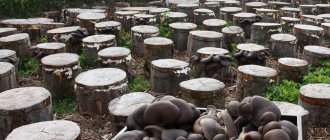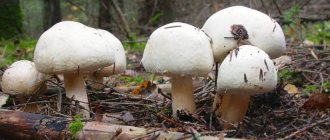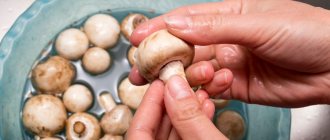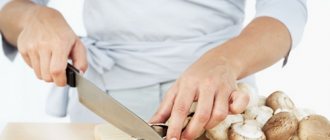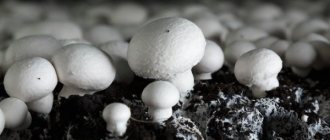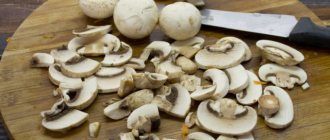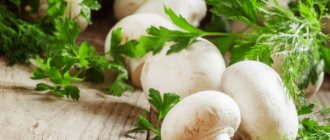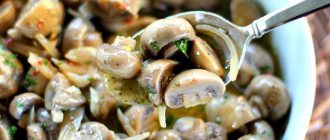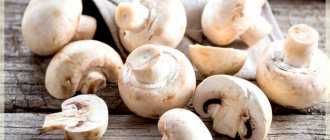The capacity of the champignon market in monetary terms is about 9 billion rubles. Previously, almost all products were supplied from abroad, but on August 6, 2014, mushrooms came under an embargo. This forced foreign producers to leave the Russian market. A niche has become available, which has allowed domestic entrepreneurs to begin earning income from the sale of mushrooms. The simple farming system and high return on investment attracted the attention of many businessmen to the industry. If an entrepreneur wants to start growing champignons, he will face competition.
1. Features and advantages of the business 2. Technology for growing champignons 3. The most productive varieties of champignons 4. What is needed to open a champignon farm? 5. Permit 6. Premises 7. Equipment 8. Personnel 9. Where to sell finished products? 10. Champignon business: profitability and payback - calculations 11. Business risks
Growing champignons as a business
Now there are many enterprises that are engaged in mushroom growing. Among them there are small households with little income, and large ones that have all the necessary industrial equipment for growing mushrooms on a large scale.
Did you know? Champignons help fight baldness due to the element they contain, such as iron.
The technology for breeding champignons has not been a secret for a long time, so almost anyone can make money from it. The main thing is to be result-oriented and follow step-by-step production instructions. You also need to remember to make a calculation of all investments and expected profitability and payback in advance. A mushroom like champignon is, of course, profitable to work with, but do not forget that it is very whimsical.
- Growing champignons for sale is worth doing for the following reasons:
- this business is not seasonal, so you can make money on it all year round;
- Harvest time can be calculated with an accuracy of up to 3 days;
- Mushrooms can be collected up to 5 times per year;
- You can grow champignons in any room that can be equipped in accordance with all production rules;
- compost is produced from animal waste, so it is easier for people who have their own farm to organize a mushroom business, because they do not have to spend money on purchasing compost raw materials;
- waste raw materials can be sold or used to fertilize garden and garden plants;
- if you organize the entire process at home, large investments are not required;
- Russia has a very stable demand for champignons, so finding markets is quite easy.
Features and benefits of business
Growing champignons as a business is an easy way to make money, which has a number of advantages:
- Growing champignons is easy;
- high-yielding mushrooms;
- raw materials are inexpensive;
- business can be conducted in a village or in a city;
- profit comes all year round.
The harvesting process involves the use of manual labor. The process can be automated, but expensive equipment will be required. The room for growing mushrooms must be constantly cleaned - failure to comply with sanitary conditions provokes contamination of the compost and soil. The quality of subsequent batches of goods may decrease, so pay attention to cleanliness.
A competent approach to doing business will allow you to get about 45 kg of products from 3 square meters. Champignons cannot harm human health. Exceptions are variegated and yellow varieties. The double-port champignon (alternative name: cultivated) is suitable for cultivation for subsequent sale.
Champignons for sale are grown industrially. The yield is 2-4 tons, so a separate plot will be required.
Documentation, do you need permission?
It is quite difficult to document the business of growing champignons. To do this, you need to collect a package of necessary documents, which includes:
- a certificate received from a phytosanitary institution confirming the compliance of the premises with established standards;
- document confirming the passage of radiological control;
- quality certificate for products indicating its validity period;
- declaration of compliance with GOST requirements;
- instructions for storage and transportation of products.
Important! The quality certificate is valid only for that batch of products that was grown on the same compost.
Only by providing all these documents can you register an individual entrepreneurship. When registering, you will need:
- application for opening, written in the prescribed form;
- copy of passport (all pages);
- a document confirming that the entrepreneur has paid the state fee.
To successfully run your business and make a good profit, it will be more profitable to switch to a single agricultural tax.
Initial investment and income
Many novice entrepreneurs are interested in how much they can earn from champignons. To calculate income, you must first calculate the initial investment. It will take about *700 thousand rubles to open a working business. At the same time, you can earn about *800 thousand rubles in a year. This calculation is relevant for a yield of 7 tons. Based on this, we can conclude that the idea is profitable. You can completely break even in the first year.
How to choose a room
Considering the sensitivity of mushrooms to changes in the external environment and to foreign microflora, you need to take a very responsible approach to choosing a room for their cultivation. Incorrect technology for arranging a place for mushroom production can lead to a significant reduction in the yield, and sometimes even to its complete loss.
Learn more about growing champignons step by step at home.
For ease of work, the best option would be to create a multi-zone system that includes four functional zones:
- A place for making and fermenting compost. Its temperature should be within +12...+16°C, and good ventilation must be installed so that the gas products of compost fermentation are effectively removed from the room. To produce about 1 ton of fertilizer, a space of approximately 20 m² is needed.
- Chamber for pasteurization of compost. It should be completely sealed, preferably have a separate entrance. It is better to make this camera yourself, although there are ready-made ones on sale, but their cost is very high, so they will not pay for themselves soon.
- Zone for sowing and growing mycelium. Here the temperature is much higher than in the first part of the room in order to create optimal conditions for growth (+24...+26°C), and air humidity must be maintained at 95–100%. Of course, you can’t do without ventilation here either.
- Room for growing crops. For normal growth, mushrooms need an air temperature slightly lower than for mycelium growth. It should be kept within +14...+16°C with a humidity of 80%.
This distribution of the production area is the most optimal, and it is excellent for beginners in this business . If you plan to buy compost that has already been pasteurized and prepared specifically for growing champignons, you can dispense with the first two zones. The room for growing mushrooms must be treated so that microorganisms contained in the air and on the walls do not spoil the entire process and reduce the yield.
Did you know? Champignons were discovered 1000 years ago in Italy.
The following measures are taken for disinfection::
- fumigation with sulfur bombs followed by mandatory ventilation;
- treating walls and ceilings with a mixture of lime and copper sulfate;
- treatment with chloroform in the presence of fungal flies in the room;
- pouring the floor with concrete to protect against high humidity, insects and rodents.
It is desirable that in each room used for mushroom production, the temperature can be adjusted depending on the purpose. It is also necessary to take care of good ventilation and additional equipment.
Basic methods of growing mushrooms
It is better to grow a champignon business using basic technologies. This will make it possible to get a good harvest.
Growing on the ground
This is the easiest way to grow champignons and oyster mushrooms. The main thing that needs to be done is special mushroom beds. These are depressions in the soil about 30 cm deep. To create a bed, you need to put drainage on the bottom, and then compact the compost and cover it with film.
Dutch growing system
In this case, a champignon business in a garage or greenhouse will take up minimal space. The organization will require special equipment, which was invented in the homeland of tulips.
In bags
A profitable option is to start by growing in bags. It is enough to purchase bags of mycelium. They are placed in a warm room and constantly watered.
When choosing this option, the costs are minimal. Additionally, you can easily cope with various pests and diseases. Simply throw away the contaminated bag. The rest will remain untouched.
In containers
Wooden containers are used for growing. Special containers are usually already treated with a special solution, which stops the development of fungi and various other pathological processes. The business can be mechanized, but the cost of the equipment will be quite high.
In briquettes
To grow a mushroom plantation, you will need to make briquettes. To do this, you will need to compress the prepared compost. After this, the most convenient blocks are formed from it.
The thickness of the compost layer should be at least 3 cm. Peat must be present. It will require about 30 kg per sq.m. compost.
Do you need any equipment?
To provide the most comfortable conditions for growing champignons, it is necessary to take care of such important issues as room lighting, air exchange, temperature and humidity.
Important! Artificially grown champignons sell best in winter and spring, and in autumn and summer the demand for them decreases due to the appearance of wild mushrooms on sale.
These conditions can be achieved using the following types of equipment:
- lamps for more comfortable work with the beds, because the mushrooms themselves do not require lighting;
- bactericidal quartz lamps;
- lamps for killing flies;
- fans to clean the air from carbon dioxide and ammonia released during compost fermentation;
- fine filter;
- air coolers and humidifiers;
- automatic climate control ;
- pasteurization device;
- water heat exchanger radiator;
- thermohygrometer;
- water heater;
- pump for watering beds with water;
- cooling chamber;
- steam generator;
- straw cutter for grinding compost components.
Also, to develop your business, you definitely need to acquire hand tools for processing beds, a wheelbarrow for moving raw materials and finished products within the premises, as well as transport for transporting mushrooms to their destination.
Requirements for premises and equipment
To become a mushroom producer, you need to have a premises that will:
- Disinfected. He is fumigated with smoke bombs.
- Divided into zones for the production and pasteurization of compost, growing mycelium, growing mushrooms. In each zone you will have to create the necessary temperature for growth.
- Constant humidity level of 60-80%. Only in this case will breeding be successful. In small rooms, the required level can be achieved by regular spraying.
- Have a size of 15 m2. This is the minimum permissible zone for mushroom growing.
- Have a concrete floor. This will prevent mice and rats from entering the room.
You may like: How much can you earn on a goose farm
Growing mushrooms as a business involves purchasing the necessary equipment. The owner will have to spend money on air conditioning, refrigerators for cooling products, a water heating boiler, lighting fixtures, a thermohygrometer, scales, transport, and a quartz lamp.
You can take both new and used equipment. The main thing is to properly organize the work of your business.
Planting material and compost: how to prepare
For growing champignons, horse manure is most valued, but if it is not available, you can use cow manure or take chicken manure, having first adjusted its acidity by adding chalk or gypsum.
In summer, compost can be prepared outside, because the air temperature allows this, and in cold seasons it is worth using special fermentation chambers, in which the temperature should not fall below +11...+13°C. Ventilation must be installed in them to remove ammonia vapors outside.
To begin with, take straw, moisten it well with water and mix it with manure (in equal proportions) or with chicken droppings (2:1). A high 2-meter pile is formed, inside which the temperature rises to 70°C. Every 4-5 days, the layers of future compost need to be mixed so that it is completely fermented. 5 such stirrings will be enough, after which the process can be considered complete.
Preparation of compost for champignons: pasteurization technology
To prepare compost for champignons, pasteurization and conditioning technology is used.
The perforated floor of the tunnel, permeable to air, is assembled from reinforced concrete or oak beams perpendicular to the long side of the tunnel with intervals between them of 3-5 cm. A tunnel with a width of 3 m is considered standard. The cross-section of oak beams is from 150 x 150 mm to 200 x 200 mm, reinforced concrete – is determined their strength. The cross-sectional shape is either square or trapezoidal with the wide base upward. In the latter case, there is less chance of clogging the cracks. The perforated floor is laid so that its surface is at ground level or at the level of the substrate workshop floor. According to the technology for producing compost for champignons, before loading the substrate, a durable bedding polymer mesh is laid on the perforated floor, which is fixed to the floor. A sliding mesh is spread on top of the bedding to pull out compost on it using an electric winch. Passage tunnels are loaded from a conveyor belt or bucket tractor, and unloaded from the other side using a sliding mesh. At a distance of 0.5 m from the gate, a stacked wall is made of horizontal beams. The wall allows the tunnel to be loaded to the desired level when the gate is open and separates the compost from the gate with a heat-insulating air space. The foundation of the tunnel forms an underground air space into which air is pumped at a pressure of 1500 Pa.
The loading schedule for compost fermented in piles or bins can be as follows.
On the 1st day - loading of the tunnel until 12 noon. Leveling the temperature in the substrate mass using recirculation air with a small supply of fresh air and heating to 58 °C in 12 hours. Pasteurization of compost for champignons lasts 10 hours, this is necessary to kill insects. Then, to condition the compost, its temperature is reduced to +48...+50 °C by increasing the flow of fresh air. Conditioning at this temperature under conditions of air blowing through the compost (10% fresh air, 90% recirculation air) lasts 5 days.
On the 6th day, the compost for growing champignons is cooled for 8-12 hours until 8 a.m. by increasing the amount of fresh air. The content of ammonium ions in the compost at the exit from the tunnel should be less than 0.1%. “Brown” compost has almost no ammonia smell.
Now Italian automatic compost presses have appeared in Russia. They immediately form compost seeded with mycelium in the form of compressed briquettes and pack them in plastic film. The size of a standard briquette is 20 x 40 x 60 cm. The surface of the film in which the block is packaged is not perforated, except for two large holes at the ends of the block, which almost do not violate the strength of the block, but provide oxygen to the mycelium in the block during transportation.
Planting and growing stages
The process of growing mushrooms consists of the following stages:
- Laying out the substrate in wooden boxes or bags in a layer of 20 cm and cooling it to +23...+25°C.
- Planting grain mycelium by spreading it over the surface at the rate of 500 g per 1 m² or placing compost (the size of a matchbox) in holes 4–5 cm deep in a checkerboard pattern. Both grain and compost mycelium need to be covered with a layer of substrate on top.
- The appearance of white cobwebby threads of mushrooms (after 1–2 weeks).
- Cover the threads with a mixture of peat, lime and earth in a ratio of 5:1:4 and lower the temperature to +12...+17°C.
- The appearance of the first solitary mushrooms followed by an increase in their number (after 3–5 days).
Did you know? Champignons
even more B vitamins than young vegetables.
We must not forget about the conditions in which champignons should grow. Lighting does not matter for them, but moistened and clean air is required, especially at the stage of forcing and growth. The first harvest appears 2–3 months after the mycelium is established.
Growing technology
There are several growing technologies: in beds, in briquettes, in bags, on racks, using technological equipment. The optimal growing technology is considered to be shelving. Thus, the effective area increases, the production volume will be greater. Depending on the height of the room, shelving is installed. The substrate can be placed directly on racks or in briquettes or boxes. The latter increases the cost of production (due to the cost of the boxes), but in the first case, if infection occurs, the mushrooms on the entire shelf will suffer.
Diseases and pests: how to protect the harvest
Champignon harvests can be affected by diseases that may cause the mushrooms to become unusable or not germinate at all. There are several types of diseases for which treatment and prevention methods have been developed.
The most common ones are:
- White rot (mycogonosis) - rotting of the mycelium with the release of a dark liquid with an unpleasant odor and deformation of the stem and cap of the mushroom. For prevention, it is necessary to ventilate the room and maintain optimal levels of temperature and humidity, and also treat the soil with a formaldehyde solution. Additionally, filters are installed for fine air purification. You also need to get rid of insects and waste substrate.
- Dry rot. It appears as a black and white coating on mushrooms or brown spots on the caps. Infected mushrooms must be removed immediately, the air must be cleared of harmful spores and insects, and hygiene rules must be followed. If the disease has spread widely, you need to treat the mushrooms with a systemic fungicide.
- False truffles on the substrate. With this disease, some of the mushrooms do not germinate, the compost becomes black, damp and smells of chlorine, and red-brown false truffle mycelium appears, infecting the soil. To protect against it, thin filters are installed on the hood, the compost temperature is maintained at the required temperature, and infected mushrooms are subject to heat treatment.
- Yellow mold forms light brown spots on the cap. It can contaminate compost, which leads to the mycelium becoming unusable, or it settles on equipment, due to which it spreads throughout the room. For prevention, it is necessary to install filters in the chambers, treat the equipment with a 2% formaldehyde solution, and fight insects and rodents. You also need to remember to wash and steam your overalls, as well as disinfect equipment and hands before adding the mycelium.
- rust spot - a disease of a bacterial nature that appears when the room is insufficiently ventilated and humidified. Even rusty spots appear on the caps. There is no cure for spotting, so the affected mushrooms are simply removed.
- floating mycelium. It appears if the cover soil and mycelium have different moisture levels. In this case, the mycelium grows upward.
- Mummification of champignons - a viral disease in which champignons turn gray and their growth stops. They must be thrown away along with the contaminated part of the compost.
Pests can also spoil the harvest, the most common of which are:
- springtails;
- woodlice;
- mites;
- roundworms;
- rodents;
- mosquitoes;
- gall midges;
- humpback flies;
- insect larvae.
Considering that chemicals used to kill insects can end up in finished products, it is better to prevent diseases.
It includes the following tools:
- processing of equipment and tools;
- preparation of compost according to all requirements;
- compliance with temperature conditions, ventilation of premises;
- treatment of cover soil with steam or formaldehyde solution;
- insulation of cultivation chambers;
- disinfection of premises with a solution of lime and copper sulfate.
Diseases
Champignons have increased sensitivity to diseases, viral, fungal and other soil lesions. Private entrepreneurs often face these problems: you will rarely find high quality compost that is not prone to disease.
Both the mycelium and an insufficiently prepared room may become infected. A strong, uninfected mycelium, subject to all the rules for growing champignons, will bear fruit well. But if you find damaged fruit or mold spots on the ground, remove the damaged elements and sprinkle the soil with salt. However, it is better to play it safe and get rid of the mycelium and the container with the substrate. The advantage of homemade champignons is that they do not contain poisons or pesticides. Therefore, the main methods of combating fungal diseases will be the disinfection of tools and premises, as well as the treatment of premises according to modern sanitary standards.
Harvesting
You need to collect champignons only by twisting them. Under no circumstances should they be plucked or cut. The hole from the mushroom is sprinkled with a covering mixture. After the harvest is complete, the remains of mushrooms and damaged mycelium are removed, the compost is thrown away, and the chamber is sterilized.
One compost usually produces 6-7 crops, appearing in waves. The first crop grows in 2–3 days, and the second crop grows in about a week. On a mushroom farm, the first four are usually used, because then the activity of the mycelium decreases and productivity drops. Champignons are collected in special containers with a capacity of 3–4 kg. They should be stored in the refrigerator at a temperature of 0...+4°C. Under these conditions they can stay fresh for up to two weeks.
Sales of champignons
It is advisable to establish sales of champignons at the initial stage of production, because they do not have a long shelf life.
They can be implemented in the following ways:
- hand over in bulk for subsequent sale, losing part of the profit but saving time;
- sell at food markets, which takes a lot of time, but the profit in this case will be higher;
- conclude an agreement for the supply of products with large supermarkets, restaurants and canneries;
- sell through eco-sites and eco-shops;
- distribute goods via the Internet using social networks or your own website.
Find out more about how to make champignon mycelium at home.
To make customers more likely to choose your product, you need to take care of its delivery. It would also be a good idea to package it beautifully if these are small batches. You can purchase special containers in advance in which the mushrooms will be stored and delivered to their destination without problems. And, of course, the products must be of high quality, and their delivery must be fast.
How much do you need to invest at the start?
To avoid unnecessary expenses, make a cost estimate.
Here is an approximate calculation in rubles for a small mushroom farm:
- business registration, collection of permits and certificates - 5,000;
- rent - 30,000;
- arrangement of the premises - 60,000;
- purchase of mycelium - 70,000;
- purchase of equipment and work tools - 250,000;
- wage fund for the first month of work - 80,000;
- advertising campaign - 35,000;
- transportation costs - 5,000;
- reserve fund - 15,000.
To start a mushroom farm from scratch, an investment of approximately 550,000 rubles is required. If we are talking about a minimum volume, at first you can get by with a much smaller amount, but in this case you cannot count on high revenue.
Possible risks
Like any business, growing champignons has its pitfalls. They must be taken into account before taking on this work.
There are such risks that can affect both the production process and the result:
- Production technology should not be violated , because the slightest deviation from the norm can lead to a decrease in yield.
- Mushrooms are very sensitive to changes in the external environment , and the slightest violation of temperature conditions, humidity, or insufficient ventilation can destroy the spores and destroy the crop or part of it.
- To make a good profit , it is necessary to ensure stability of work and take care of sales channels in advance. The entire technological process must be clearly debugged from start to finish.
- Watering should be done only by sprinkling , otherwise the mushrooms may not sprout.
- The price level for finished compost is rising significantly , which can significantly increase production costs.
- It is better to buy mycelium ready-made and from trusted suppliers , since it is almost impossible to grow it at home. Most often, self-cultivation ends in a waste of money.
- Since the demand for mushrooms is quite high , more and more enterprises engaged in their cultivation are appearing, which greatly increases the level of competition. To be successful in this business, you need to constantly improve the quality of the product and take advantage of other competitive advantages.
- Business can be affected by natural disasters , fires, emergencies, from which you can protect yourself by taking out insurance.
Product Description
Before considering the technology for growing champignons on an industrial scale, you should pay attention to the features of this product. This is important for running a business.
Champignons contain many nutrients that participate in the body's metabolic processes. The product contains not only carbohydrates, but also fats, vitamins, nitrogenous substances, minerals, and proteins. In addition, the composition includes more than 20 types of amino acids.
Compounds that are beneficial for the human body are zinc, iron, phosphorus, and potassium. Regular consumption of champignons helps strengthen the immune system. Champignons contain approximately the same amount of phosphorus as seafood.
It is worth noting that this mushroom can be eaten during a diet. The calorie content of the product is low. At the same time, the quality composition of the mushroom is high, which allows you to diversify your diet and supplement it with useful minerals and vitamins. The composition contains virtually no sugar, so champignons are included in the list of permitted foods for diabetics.
This mushroom has a positive effect on the body due to the presence of large amounts of vitamin B2 and B1. They prevent the development of migraines, relieve chronic fatigue, and improve the appearance of the skin. In dry form, champignons are used for diseases of the gastrointestinal tract and liver.
For all its beneficial qualities, this mushroom is very tasty. To preserve all the positive qualities of this product, you need to know how champignons are grown in industrial conditions.
Growing at home
The amount of investment in a business depends on how many finished products you plan to receive as a result. If you want to harvest a small harvest, you can start working at home. A basement or other room where you can place wooden containers or bags is perfect.
Important! With a strong increase in temperature, champignons stop growing, but then their growth is restored.
The main thing is to make a plan and study the demand for this type of mushroom in your region in order to start making money from it in the future. Both in factory conditions and at home, you must adhere to certain rules for equipping premises and growing crops.
Breeding champignons can very well become a good profitable business if you approach the issue seriously, take into account all possible risks and find markets in advance. According to reviews, it is advisable to immediately try your abilities by growing a small volume of products, and only with good results expand the scale of production. What equipment is required to grow champignons?
Mycelium
Another important expense item in the business plan is the mycelium for growing champignons. The technology of this process involves the use of a special substrate that contains fungal spores. The latter are called mycelium. To start your own business for growing champignons, you will need to contact a specialized company that sells such soil.
It is highly not recommended to cooperate with little-known organizations. To purchase high-quality mycelium, which will allow you to reap a good harvest, you need to contact only trusted companies. They have been working in the market for many years and value their reputation. Therefore, you can be sure that they supply high-quality soil with viable mycelium.
Fungal spores can be of two types, which are characterized by approximately the same degree of germination. The mycelium can be grain or compost. According to the generally accepted statement, the first variety is still better. But novice entrepreneurs are recommended to use compost mycelium. This variety is less sensitive to violations of growing, storage and transportation technology than the grain variety. At the same time, compost mycelium is not afraid of rodents.
First, you will need to qualitatively study all the recommendations and features of mushroom growing, and detailed technology for growing champignons. When an entrepreneur learns all the intricacies of this process, he will be able to move on to growing grain mycelium. This species produces a more abundant harvest.
You should not prepare mycelium yourself if the company will exclusively sell mushrooms. It is better to purchase growing material separately. Preparation of mycelium is a rather complex technique that requires special equipment and experience.
